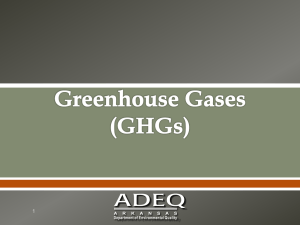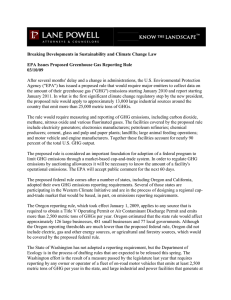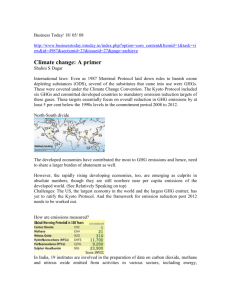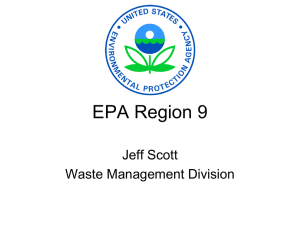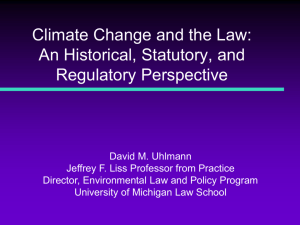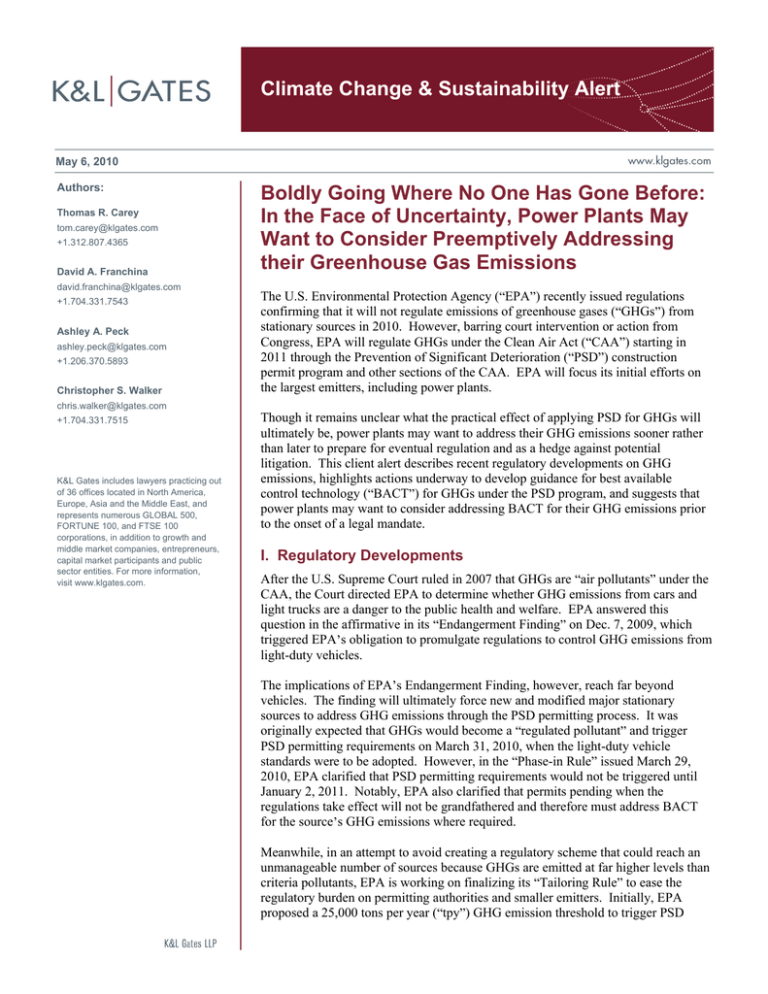
Climate Change & Sustainability Alert
May 6, 2010
Authors:
Thomas R. Carey
tom.carey@klgates.com
+1.312.807.4365
David A. Franchina
david.franchina@klgates.com
+1.704.331.7543
Ashley A. Peck
ashley.peck@klgates.com
+1.206.370.5893
Christopher S. Walker
Boldly Going Where No One Has Gone Before:
In the Face of Uncertainty, Power Plants May
Want to Consider Preemptively Addressing
their Greenhouse Gas Emissions
The U.S. Environmental Protection Agency ( EPA ) recently issued regulations
confirming that it will not regulate emissions of greenhouse gases ( GHGs ) from
stationary sources in 2010. However, barring court intervention or action from
Congress, EPA will regulate GHGs under the Clean Air Act ( CAA ) starting in
2011 through the Prevention of Significant Deterioration ( PSD ) construction
permit program and other sections of the CAA. EPA will focus its initial efforts on
the largest emitters, including power plants.
chris.walker@klgates.com
+1.704.331.7515
K&L Gates includes lawyers practicing out
of 36 offices located in North America,
Europe, Asia and the Middle East, and
represents numerous GLOBAL 500,
FORTUNE 100, and FTSE 100
corporations, in addition to growth and
middle market companies, entrepreneurs,
capital market participants and public
sector entities. For more information,
visit www.klgates.com.
Though it remains unclear what the practical effect of applying PSD for GHGs will
ultimately be, power plants may want to address their GHG emissions sooner rather
than later to prepare for eventual regulation and as a hedge against potential
litigation. This client alert describes recent regulatory developments on GHG
emissions, highlights actions underway to develop guidance for best available
control technology ( BACT ) for GHGs under the PSD program, and suggests that
power plants may want to consider addressing BACT for their GHG emissions prior
to the onset of a legal mandate.
I. Regulatory Developments
After the U.S. Supreme Court ruled in 2007 that GHGs are air pollutants under the
CAA, the Court directed EPA to determine whether GHG emissions from cars and
light trucks are a danger to the public health and welfare. EPA answered this
question in the affirmative in its Endangerment Finding on Dec. 7, 2009, which
triggered EPA s obligation to promulgate regulations to control GHG emissions from
light-duty vehicles.
The implications of EPA s Endangerment Finding, however, reach far beyond
vehicles. The finding will ultimately force new and modified major stationary
sources to address GHG emissions through the PSD permitting process. It was
originally expected that GHGs would become a regulated pollutant and trigger
PSD permitting requirements on March 31, 2010, when the light-duty vehicle
standards were to be adopted. However, in the Phase-in Rule issued March 29,
2010, EPA clarified that PSD permitting requirements would not be triggered until
January 2, 2011. Notably, EPA also clarified that permits pending when the
regulations take effect will not be grandfathered and therefore must address BACT
for the source s GHG emissions where required.
Meanwhile, in an attempt to avoid creating a regulatory scheme that could reach an
unmanageable number of sources because GHGs are emitted at far higher levels than
criteria pollutants, EPA is working on finalizing its Tailoring Rule to ease the
regulatory burden on permitting authorities and smaller emitters. Initially, EPA
proposed a 25,000 tons per year ( tpy ) GHG emission threshold to trigger PSD
Climate Change & Sustainability Alert
permitting requirements for new construction (and
between 10,000 and 25,000 tpy for major
modifications of existing sources). More recently,
EPA Administrator Lisa Jackson stated that for the
first six months of 2011, EPA will apply PSD only
to sources that must comply with PSD for criteria
pollutants and for at least 18 months after that
EPA will apply PSD only to sources with GHG
emissions exceeding 75,000 tpy.
All the moving pieces to EPA s regulation of GHGs
under the CAA provide avenues for legal challenges,
leaving significant uncertainty as to whether EPA s
timeline (and authority) to regulate GHGs will
remain intact. The Endangerment Finding is
currently being challenged by several industry
groups, lawmakers, and three states. Many of these
challengers are also attempting to have the Phase-in
Rule struck down. These challenges could delay
EPA s timeline if a court enjoins GHG regulation
pending outcome of the suits. If the Endangerment
Finding is invalidated (e.g., through congressional
action), EPA may also find itself with nothing to
stand on to regulate GHGs under the CAA.
The final Tailoring Rule is also expected to face
challenges from both industry and environmental
groups. The problem for EPA is that the CAA
clearly states that the PSD program applies to new
sources emitting 100 or 250 tpy of air pollutants.
Even though these lower thresholds are arguably
unworkable for GHGs, it would not be surprising to
see industry and environmental groups aligned in
arguing that the Tailoring Rule violates the
unambiguous provisions of the CAA; namely, the
statutory 100 and 250 tpy thresholds.
In the backdrop of these court challenges, efforts are
being made in Congress to push through a
comprehensive federal climate change bill. Thus,
even if EPA is successful in defending its recent
rulemakings, a federal climate bill also remains a
mechanism available to sidestep the agency s efforts
to address GHGs under the CAA a situation EPA
would actually prefer. In a bipartisan effort,
Senators Kerry, Graham, and Lieberman were
expected to introduce a climate bill on April 26. The
process was derailed when Senator Graham pulled
back on his support after Senator Reid proposed to
put immigration reform ahead of climate legislation.
In response, on April 27 EPA issued a Climate
Change Indicators Report outlining the negative
climate impacts of increased GHG emissions in the
United States a move some believe is the Obama
Administration s attempt to turn up the heat on
keeping congressional action on climate legislation
moving before the mid-term elections. Given this
political wrangling, and regardless of where you sit
on the aisle, it is hard to imagine a climate bill
making it through Congress before EPA s GHG
regulations take effect in 2011.
II. EPA s Climate Change Work Group
Addressing BACT
Assuming EPA s regulations withstand legal
challenge in their current form and Congress does
not preempt EPA s actions, the largest GHG
emitters, including power plants, are likely to
become the first guinea pigs required to address
BACT for GHG emissions beginning in 2011.
Apart from switching from coal to natural gas and
increased operational efficiencies, the technical
controls that will constitute BACT for GHGs are a
mystery at this point. In other words, there are no
clearly established GHG emission control
technologies to capture GHGs. To address this
situation, EPA established the Climate Change
Work Group ( Work Group ) in October of 2009 to
identify and address major issues for implementing
the PSD requirements for GHGs, and BACT
analysis in particular. The Work Group s findings
will be used by EPA to develop guidance and assist
states and regulated entities in implementing and
complying with the new GHG regulations.
During its initial meeting, the Work Group
disagreed as to whether BACT should be applied to
GHG sources in the same manner as it is currently
applied to other criteria pollutants or whether EPA
may or should adopt a different approach for GHGs.
Because this disagreement fundamentally affected
the framework for discussions, the Work Group
decided to focus the first phase of its work on
providing recommendations to help EPA craft
BACT guidance for GHGs assuming, at least
initially, that the process would occur in the same
manner as criteria pollutants. During the second
phase, which commenced on January 1, 2010, the
Work Group will consider possible alternative
approaches to applying the PSD program to GHG
sources and whether these approaches are consistent
with the requirements of the CAA.
May 6, 2010
2
Climate Change & Sustainability Alert
The Work Group released its Interim Phase I Report
on February 3, 2010, in which it summarizes its
discussions on several issues related to BACT
analysis under EPA s longstanding top-down
approach for criteria pollutants. These issues
include:
Of note, the Work Group agreed that the application
of energy efficiency was an effective method of
securing GHG and other emission reductions and
should be included in BACT analysis as a factor in
evaluating alternatives and in setting emission
limits. This is critical for power plants because:
1. the scope of BACT analysis and defining the
source ;
1. efficiency may be the most cost-effective way
to control GHG emissions without requiring
modifications that would fundamentally change
the project purpose; and
2. criteria for determining feasible control
technologies;
3. criteria for eliminating technologies; and
4. the technical information needs of states
regarding control and mitigation measures.
While identifying some general areas of agreement,
the report largely highlights the many questions EPA
will face in applying the PSD permitting process to
GHGs. The Work Group suggested several actions
that EPA should take to help address these
uncertainties, including:
Expanding the RACT-BACT-LAER
Clearinghouse (a searchable central database of
air pollution technology to aid in selection of
emission controls) to include information
regarding construction status, controls installed,
and compliance test results for projects where
GHG controls have been applied;
Exploring ways to encourage the use of
innovative GHG control technologies;
Providing sector-specific guidance on evaluating
energy efficiency in a BACT analysis;
Developing a periodic GHG control measures
newsletter and distributing to permitting
authorities and other interested parties;
Proactively collecting permit decisions with
adequate documentation and making them
available to stakeholders;
Developing guidance on appropriate methods or
formulas for calculating the costs of GHG
controls and other various approaches and
technologies for GHG reductions; and
Providing guidance on how clean fuels should
be considered in the BACT analysis.
2. alternative capture technologies for GHGs are
nonexistent.
During its deliberations, the Work Group also
reviewed a case study involving a voluntary GHG
BACT analysis conducted for Calpine
Corporation s 612 megawatt natural gas-fired power
plant in Hayward, California, the first power plant
in the country to be subject to GHG emissions
limits. The analysis concluded that high-efficiency
power generation technology was the only available
and feasible control technology for GHGs. The
final permit incorporated an output-based efficiency
limit of 7,730 Btu/Kwh for GHGs. Though the
Work Group does not cite this case study in its
report, the Calpine project will likely become a
model for applying BACT to other power plants.
III. Potential Interim Options for
Power Plants
Although future guidance from EPA and findings
from the Work Group may eventually provide more
direction regarding the obligations permittees will
face in applying BACT for GHGs, the most
concrete guidance may be provided by permittees
who go through the process first. The obvious
inclination may be to push permits for new projects
and expansions through before the regulations take
effect if at all possible, and then wait and see
whether the regulations are invalidated or modified
through court challenges or federal legislation.
However, a more prudent approach may be to get
ahead of the curve by voluntarily evaluating BACT
now even in the absence of a legal mandate to do
so.
Despite the uncertainty involved, the first permittees
to address BACT for GHG emissions will
undoubtedly play a critical role in developing the
national model to be applied to similar projects in
May 6, 2010
3
Climate Change & Sustainability Alert
the future. This presents a unique opportunity for
permittees to advocate for more feasible and costeffective GHG control technologies, such as energy
efficiency, as examples of BACT to be applied to
their own future modifications. Given EPA s
position that PSD will be applied to GHGs for all
pending permits when the regulations take effect,
voluntary compliance early on could also provide
valuable insurance in the event of unforeseen
permitting delays.
Preemptively addressing BACT for GHGs could
also serve to inoculate projects from potential legal
challenges involving their GHG emissions under
authorities other than the CAA. For instance,
plaintiffs groups may very likely cite the
Endangerment Finding and the Supreme Court
decision on GHGs in common law nuisance actions,
or in arguing that a project proponent must address
the environmental impacts of GHG emissions under
the National Environmental Policy Act ( NEPA )
or a state law analog. Voluntarily addressing a
project s GHG emissions through BACT analysis
early on may provide support in a NEPA or state
impacts analysis or in defending a nuisance action.
Proactively addressing GHG emissions could also
provide a valuable public outreach opportunity and
in some circumstances assuage concerns of project
proponents, keeping legal challenges to a minimum.
Anchorage Austin Beijing Berlin Boston Charlotte Chicago Dallas Dubai Fort Worth Frankfurt Harrisburg Hong Kong London
Los Angeles Miami Moscow Newark New York Orange County Palo Alto Paris Pittsburgh Portland Raleigh Research Triangle Park
San Diego San Francisco Seattle Shanghai Singapore Spokane/Coeur d Alene Taipei Tokyo Warsaw
Washington, D.C.
K&L Gates includes lawyers practicing out of 36 offices located in North America, Europe, Asia and the Middle East, and represents numerous
GLOBAL 500, FORTUNE 100, and FTSE 100 corporations, in addition to growth and middle market companies, entrepreneurs, capital market
participants and public sector entities. For more information, visit www.klgates.com.
K&L Gates is comprised of multiple affiliated entities: a limited liability partnership with the full name K&L Gates LLP qualified in Delaware and
maintaining offices throughout the United States, in Berlin and Frankfurt, Germany, in Beijing (K&L Gates LLP Beijing Representative Office), in
Dubai, U.A.E., in Shanghai (K&L Gates LLP Shanghai Representative Office), in Tokyo, and in Singapore; a limited liability partnership (also named
K&L Gates LLP) incorporated in England and maintaining offices in London and Paris; a Taiwan general partnership (K&L Gates) maintaining an
office in Taipei; a Hong Kong general partnership (K&L Gates, Solicitors) maintaining an office in Hong Kong; a Polish limited partnership (K&L
Gates Jamka sp. k.) maintaining an office in Warsaw; and a Delaware limited liability company (K&L Gates Holdings, LLC) maintaining an office in
Moscow. K&L Gates maintains appropriate registrations in the jurisdictions in which its offices are located. A list of the partners or members in each
entity is available for inspection at any K&L Gates office.
This publication is for informational purposes and does not contain or convey legal advice. The information herein should not be used or relied upon
in regard to any particular facts or circumstances without first consulting a lawyer.
©2010 K&L Gates LLP. All Rights Reserved.
May 6, 2010
4

